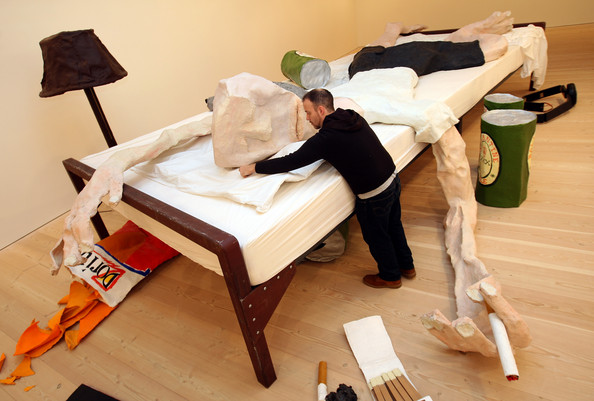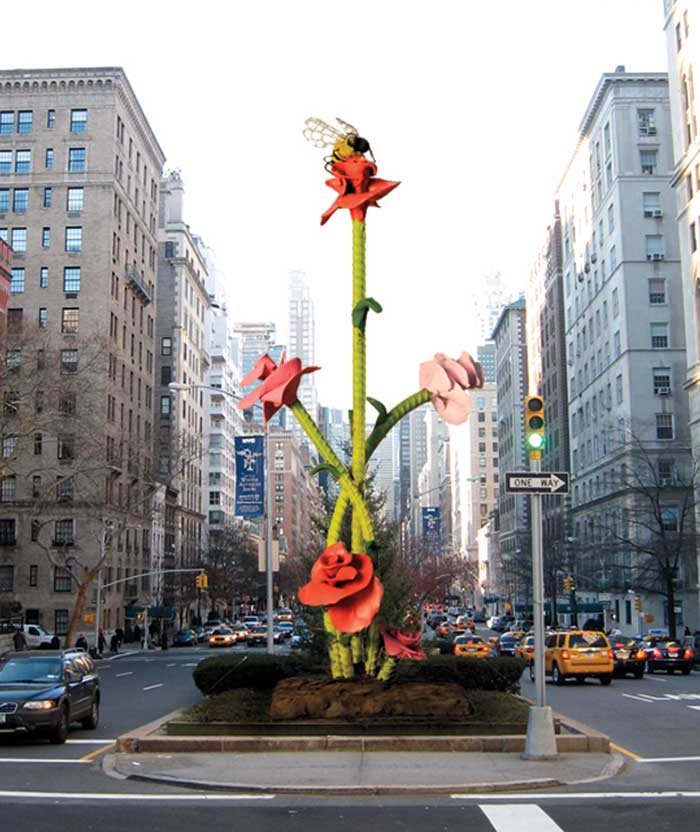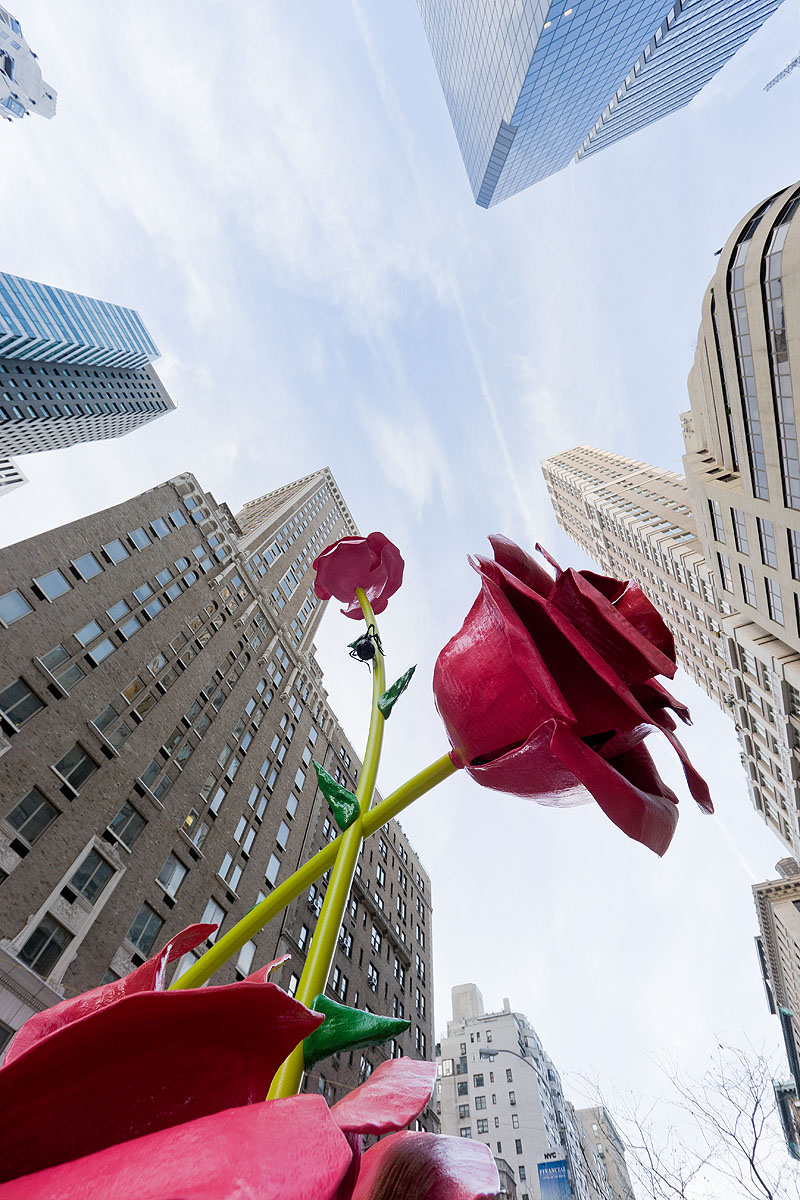
Will Ryman took a somewhat roundabout route to sculpture. For something like a dozen years he maintained a career as a playwright, and - as he explains here - he continues to draw many of his references from the world of theatre and cinema. It was so that he could better explore the personality of one of his fictional characters that he first attempted to bring him into existence with scrap materials. Similar figures - at once comic and vaguely threatening - are the pieces with which Mr Ryman first established his sculptural reputation (at the 2005 Greater New York show at P.S.1, for example, and at London's Saatchi Gallery in in 2009). 
That same year however, in an exhibition with the significant title A New Beginning at Marlborough Chelsea, he showed a series of large scale sculptures of flowers crawling with bugs, and now he is about to become one of the New York City's best known artists with similar work: his installation The Roses - comprising 38 blossom sculptures and 20 individual rose petals - was unveiled on Monday on Park Avenue's median between 57th and 67th Streets. Last weekend these sculptures were the subject of a full-page article in the New York Times, and this Sunday the New York Post called them "The Stalk of the Town"(!)
When I spoke to Mr Ryman during his final preparations for the installation last week, we got into a fascinating conversation on the differences between performance and sculpture, about the merits of public sculpture in general, and about Christo and Jeanne-Claude's Gates, but I began by asking him about the sources of the current project.
Will, tell me how the idea for The Roses came about.
The idea was born out the film Blue Velvet which I saw when I was a kid. The opening scene of that movie really struck me. I'd never seen anything like that before, and I knew that I wanted to do something like that, in terms of changing the meaning of what you see. The opening shot is basically the typical American Dream - the white picket fence, the really nice house, the manicured garden - and then the camera pans down to this underworld and the magnifies everything underneath, like the worms and the dirt. Then the movie takes you into this dark underworld, because that's where the story lies. That rang true to me, and the installation up on Park Avenue was inspired by that. You see these beautiful objects, and then I add the bug element to it, and the scale element, which changes it even more. The thorns are about a foot long. It's a bit menacing, you know?
There's an underlying darkness to them certainly, which I've always thought of as typical of your work.
Yes. I think most of my work comes from that place. I was very inspired by the absurdist playwrights - Beckett and Ionesco are two of my favorites - and so I bring that to my work. Most of what I do involves some form of absurdism, or comes out of particular scenes in plays or movies that have really inspired me.
I'm fascinated by your shift from theatre into sculpture. A lot of artists who make that journey finish up making performance art. You weren't tempted by that?
No, not at all. In fact, I wanted to remove all the actors. I wanted the objects to have all the movement and I wanted the objects to have all the humanity. People are a lot less interesting than objects, or what objects can do in terms of art. My vision is better realized with materials than it is with performance. I don't really go to the theatre today, and I really didn't like most of the theatre that I saw. The theatre that I responded to was completely non-conventional and not commercial and was more introspective and more about philosophy. I didn't respond to people "acting". It looks false and it usually comes across as very staged. I thought that really wasn't interesting at all. I don't find that to be the case in sculpture. I think that when objects are performing, it's much more of an experience. On Park Avenue I want to convey the sense that these giant objects look like they're moving and dancing up the avenue.
You'd prefer that a sculpture suggest movement, rather than have a person act it out?
There's a big difference between sculpture and theatre, and I think what distinguishes the two is the concept of time, or events that take place in time. A lot of sculpture, especially if you go back to Rodin and people like that, tried to sculpt events in history, which I guess were theatrical. But as sculpture evolved it became more about removing the element of theatre, and psychology, and emotion, and it became more about the objects and actually about what the materials are doing. But with my stuff I'm trying to both: I'm exploring the materials, and although I don't ever sculpt events or anything historical that we've already seen, I try to sculpt what I've experienced, or how I interpret things. What appeals to me is a combination of movement and stillness, which is what a sculpture is, I suppose.
I think this also has something to do with human presence. One aspect of the difficult history of public sculpture in New York - and I'm thinking way back to Richard Serra's Tilted Arc - has stemmed from the abstracted nature of its human presence.
Yes. That's a good point. I think a lot of public art fails because wherever art is - whether it's in a gallery or a museum, or whether it's in public or in someone's home, it is always in a dialog with its surroundings, whether you want it to be or not. And if it doesn't make sense to its surroundings, it's not going to work. I think with a lot of public art, galleries just take what they have in inventory and they plop it out on the street with no contextualization or anything like that. So it doesn't work because it has nothing to do with its environment. With my sculptures on Park Avenue, on the other hand, I took everything into account. In other words the installation isn't complete until it's out on the street and the surroundings are interacting with it. Otherwise it just doesn't work. The sculptures are going to be interacting with the buildings, with the traffic lights, and with the public scurrying around them. This is why I wanted them so tall because I wanted the people up in the buildings to have a dialog with them as well as the people on the street. Even the sky and the seasons have a lot to do with it. I wanted them to be there in wintertime because of the color. I thought the surroundings would be the perfect canvas for these kind of things. New York is all these straight line: the tall buildings, the streetlights, the gray industrial backdrop, and the blue-gray sky. Hopefully all of this will enhance these awkward dancing blossoms that are out on the street. 
That's why The Gates were so successful - because they embraced the environment in Central Park. And the Park glowed. They made the whole Park glow. The Park needed The Gates to work, and The Gates needed the Park to work. The individual objects that were in the Park, with those pieces of orange cloth, just didn't work for me as much as the installation as a whole - combined with Central Park, combined with February. I don't know that that The Gates would have worked nearly as well in the summertime.
Perhaps that is why the City was so keen to work with you on this piece. I know that the Mayor is still very conscious of how much benefit New York City derived from The Gates.
I agree. When art fits into its environment and has a dialog with its environment in a perfect way like that it can really uplift the whole city, which is what I think happened back then.
And is that your ambition for The Roses?
Yes, that's right. I hope it inspires people. I hope it uplifts the city. I've had the idea for quite a while, actually: a site-specific installation for Park Avenue, because Park Avenue is known for its floral displays. I spent about five months putting together a proposal and I took it directly to the City. I met with the Commissioner of the Parks Department in August 2009, and they've been great: the Commissioner, and Jonathan Kuhn and Jennifer Lantzas in the Parks Department, and my fabricator, Konstantin Bogdanov from KB Projects in Greenpoint, Brooklyn. The all deserve my thanks.
Let's finish up by talking about humor in art. Is humor a way a way in for people?
Absolutely. It's just more engaging that way. It becomes much more interesting. When it's just darkness for darkness's sake, it can really be off-putting. It creates a wedge between the viewer and the piece. But when there's humor it invites the viewer in to engage with it more. It becomes more of an experience when you're laughing at something, even when you don't know why you're laughing - either because it's so grotesque, or because it's funny, or for whatever reason. Some of the greatest, funniest plays and movies that I've seen are tragedies. Tragedy has more impact when you're laughing, just as the humor has more impact when there's real darkness behind it. As an artist you seek the truth. You seek whatever's true for you, and that usually combines humor with anything else that's involved.
Park Avenue Photos: Iwan Baan